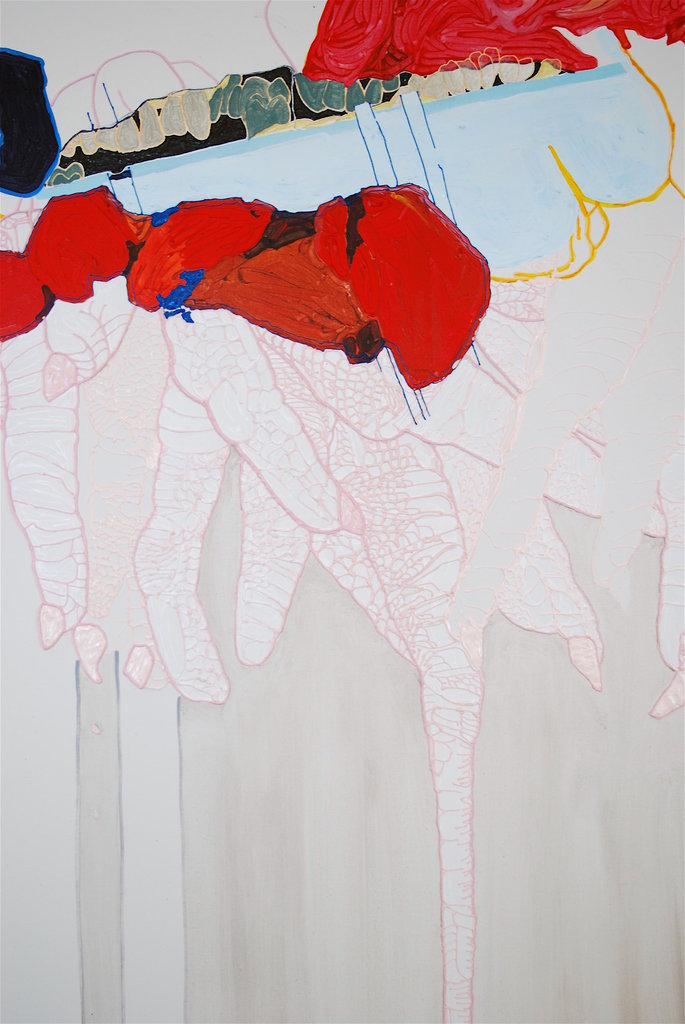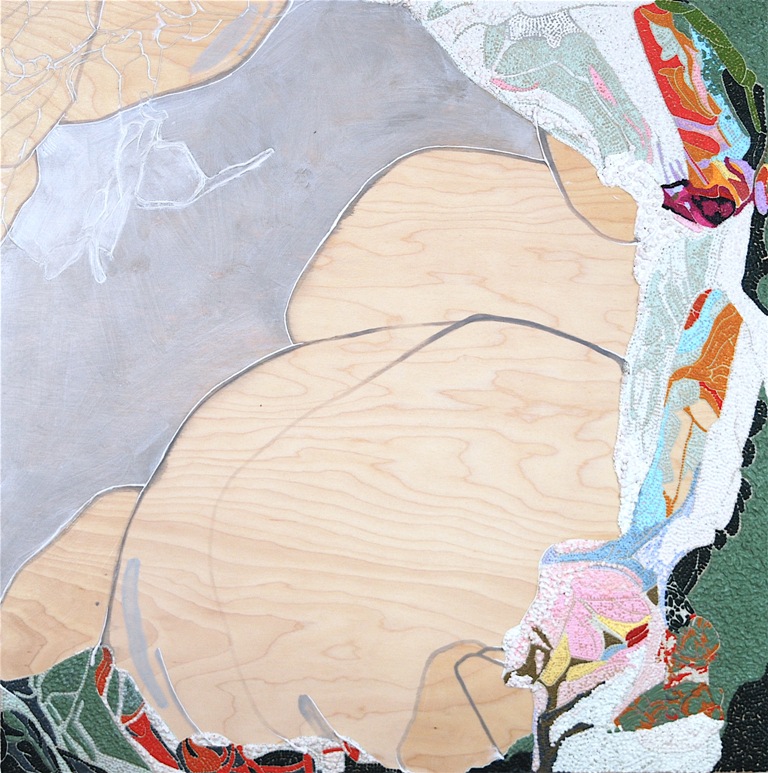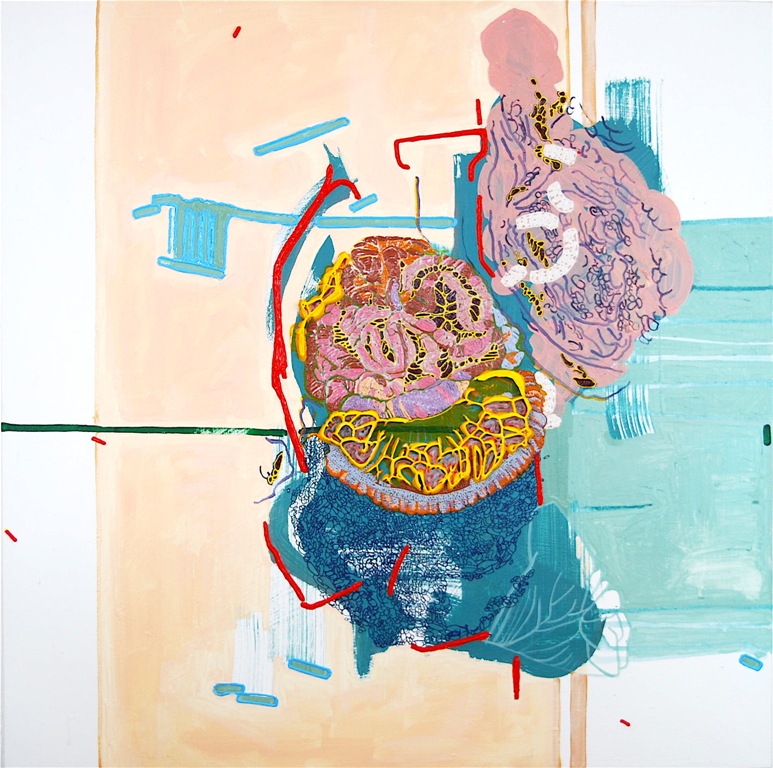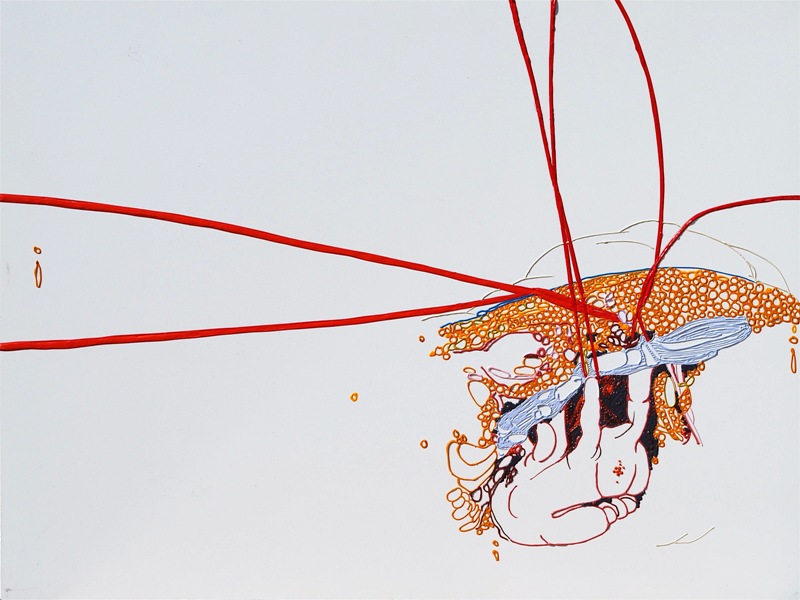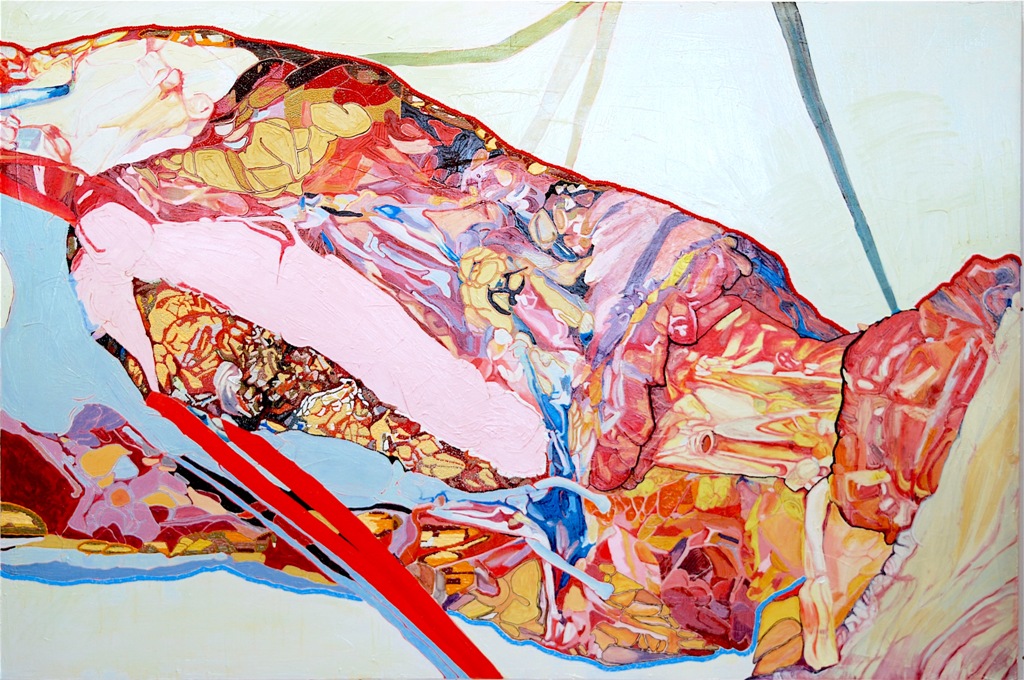Whatever Seo Eun Kim is looking at, she turns into art – even something as trivial as a chicken foot.
The inspiration for her latest series, Examples of Suture, came from the least expected place: the kitchen of a restaurant. She was watching the cook butchering a fish, the head, the opened belly, the organs coming out – with fascination. She watched the same happen with a chicken and then, wanting to see more, she approached some butchers and asked to observe them at work. After a while she became even more intrigued and attempted to partake in classes where they were dissecting cadavers – human cadavers. They have very strict privacy issues, so she never attended any of those classes but instead she turned to anatomy books with detailed images of organs.
Kim uses this imagery in a unique way, creating a mostly abstract composition mixed with realistic body parts that are easy to recognize. In Filtered Collage #2 the top of the canvas is covered with the deep red of bloody organs, surrounded by the waxy texture of glands and fat, that runs down to the bottom of the painting in rivulets. At the top left, there are teeth from a mammal, maybe even human, coming out of a greying mass suggestive of intestines and underneath that are more bloody organs, from which emerge some chicken feet.
Seo Eun Kim, Filtered Collage #2, detail, 2018, acrylic on canvas, 60″ x 60″
Strained #13 is mostly an blank wood panel, a negative shape, that, with a few lines, has been turned into the big body of a Buddha, a sumo wrestler or a very pregnant woman. The body is surrounded by very fine layers of textured paint that look like embroidery with small little stitches and dots, reaching out into the third dimension of the space.
Seo Eun Kim, Strained #13, 2018, acrylic on panel, 24″ x 24″
The next image in this strange theme is the actual wound and the closing of it so it can heal using sutures, hence the title. In Suture #4, we can see an open belly with all the intestines and fatty tissues. Kim imagines herself performing the surgery but instead of surgical tools she uses pastry decorating tools. Instead of metal or plastic thread she uses paint. The paint becomes both the flesh of the body and the suturing material. Kim applies the oil paint with such loving care that the strokes become extremely small and delicate, like the fine patterns seen on a wedding cake.
Seo Eun Kim, Suture #4, 2018, acrylic on canvas, 30″ x 30″
Kim never overpaints. She loves empty surfaces broken by a calligraphic motif, maybe an echo of her Korean background. Sieve #15, is a filtered version of the rich imagery of this show, showing only the essence of the idea.
Seo Eun Kim, Sieve #15, 2018, acrylic on panel, 12″ x 16″
Suture #1 is an extremely complicated and rich painting. The surface of the canvas is almost filled – an unusual compositional approach from Kim. There is hardly any empty space around the image but to balance negative and positive areas, there is a white shape in the middle, a closed emptiness. The outline of the animal reminds me of a large fish, butchered and bloody. However, it is not scary or disgusting. Rather the opposite – it is almost beautiful. The way Kim has painted the details of its inside are more appealing than repulsive. The viewer can’t get enough of the hundreds of tiny details and formations – even if they represent air sacks, organs, intestines or fatty tissues. Looking at this large painting you don’t even think about what certain forms are, you just lose yourself in its components. As Kim stated, “Through disassembling, abstracting, and suturing, human and nonhuman flesh and viscera unhinge from their source images and become collages of fused corporeal textures.” The colors are so rich and stunning, the harmony is amazing. All the hues of red, yellows, warm oranges and soft violets are there, touched up by just a little blue, but in crucial places of the composition – making the painting very vibrant.
Seo Eun Kim, Suture #1, 2018, acrylic on canvas, 48″ x 72″
Examples of Suture is a very unusual exhibition, not just because of its strange theme but also because of Kim’s method of composition and her use of paint. Some of the original animals or body parts can still be identified but through the actual painting they lose their significance and become abstracted; mixing the real and surreal – taking us into a different world. She enhances her rather morbid imagery with delicate strokes and colors – so the ugly body parts go through a metamorphosis and become almost beautiful. Kim is a talented young artist and a colorist worth watching in the future.
Emese Krunák-Hajagos
Images are courtesy of the artist and Yumart
*Exhibition information: September 8 – 29, 2018, Yumart, 401 Richmond Street West Suite B20, Toronto. Gallery Hours: Wed – Sat, 12 – 6 pm.

